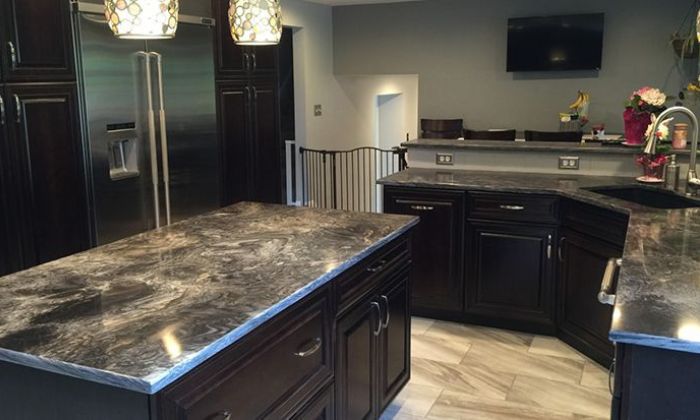Is Granite Heat Resistant?
Yes, granite is heat resistant, able to shrug off temperatures up to around 1,200 °F without cracking or discoloration. Formed deep underground by volcanic activity, this igneous rock owes its strength and remarkable thermal tolerance to an interlocking crystalline structure created under extreme heat and pressure. In everyday kitchens, that means hot pots and pans won’t leave marks or scars on the stone itself, though the thinner sealant layer may need a little extra care. How well your countertop handles heat over time depends on expert granite fabrication, where precise cutting, polishing, and multi-layer sealing lock in its natural resilience. In this article, we’ll explore why proper fabrication matters, compare granite’s thermal performance with other surfaces, and share simple tips to keep your stone looking stunning and fully functional.

Table of Contents
ToggleComparison with Other Countertop Materials
When considering countertop materials, granite stands out for its heat resistance. However, it’s beneficial to compare granite with other popular options to see how they stack up against high heat.
Quartz
Quartz countertops are crafted from natural quartz crystals mixed with resins, resulting in a durable, attractive surface. However, quartz has lower heat resistance than materials like granite. Exposing quartz to high temperatures, such as placing hot pots or pans directly on it, can cause the resin within to warp or discolor.
This makes quartz less ideal for high-heat situations, and it’s recommended to use trivets or hot pads to protect the surface. Despite this, quartz countertops are popular for their durability, stain resistance, and ease of maintenance, making them a great choice for many kitchen designs.
Marble
Marble is a beautiful, natural stone often used in kitchens, but it’s less heat-resistant than granite. It can handle moderate heat; however, exposure to hot pots and pans risks cracking and discoloration. For this reason, marble surfaces need extra care when handling hot items to avoid damage. Despite this, its elegant appearance makes it a popular choice, though users should be mindful of its limitations with heat.
Solid Surface
Solid surface countertops, such as Corian, are popular for being non-porous, which makes them resistant to stains and easy to clean. They can withstand moderate heat, but excessive temperatures can cause warping or melting.
To avoid damage, homeowners should use heat-protective measures, like trivets or hot pads, for items straight from the oven or stovetop. While durable and low-maintenance, these surfaces are best suited for households that can handle them with care, ensuring hot objects are not placed directly on them.
Laminate
Laminate countertops are less heat-resistant than most materials, making them vulnerable to burns and damage from hot pans. Direct contact with high-temperature items can easily leave scorch marks on laminate surfaces, so it’s best to avoid placing hot objects on them directly.
In contrast, granite countertops are more durable with heat. They can handle hot items better than laminate, but using trivets or hot pads is still recommended to maintain their quality and appearance over time. Granite’s superior heat resistance makes it a better choice for those who need a countertop material that can withstand higher temperatures.
Can Granite Be Used as a Cooking Surface?
Using granite as a cooking surface can be an attractive option for many home chefs. Granite slabs can be installed as a large cooking area, perfect for rolling dough or preparing food. However, while granite can handle heat, it is essential to remember that direct exposure to hot pans or extreme heat may lead to potential issues.
For instance, setting a hot pan directly on granite can be done occasionally without damage, but it is not advisable as a regular practice. Regular exposure to high heat can lead to long-term damage, especially if the granite is subjected to rapid temperature changes. Therefore, while granite can function as a cooking surface, it is best to err on the side of caution and use additional protective measures.
Can You Put Hot Stuff On Granite?
Yes, granite countertops can withstand heat from hot pots and pans, but caution is key to preserving their durability. While granite’s natural resilience makes it heat-tolerant, consistent exposure to high temperatures may cause gradual damage. Using trivets or hot pads is recommended to prevent potential harm from excessive heat.
It’s also wise to avoid placing extremely hot items directly on granite—allow them to cool slightly first. Sudden temperature changes, such as placing cold items on hot granite, can lead to thermal shock. Taking these simple precautions will help maintain your granite countertop’s beauty and longevity.
Signs of Heat Damage on Granite
Even though granite is heat resistant, it is not completely immune to heat damage. Being aware of the signs of potential heat damage can help you take action before it worsens. Here are some common indicators:
Cracks or Fissures: If you notice small cracks appearing on your granite countertop, this could indicate thermal shock or damage from hot items.
Discoloration: Darkening or fading of the granite’s surface may suggest exposure to high heat levels over time, leading to potential damage.
Warping or Distortion: While rare, significant heat can cause warping in some types of granite, especially if the stone is not properly installed.
If you observe any of these signs, it may be time to consult a professional for repairs or restoration to preserve the integrity of your countertop.
Practical Tips for Protecting Granite from Heat Damage
To protect your granite countertops from heat damage, always use trivets or hot pads when placing hot pans on the surface, as this helps prevent thermal shock. Avoid setting hot items directly on the granite whenever possible. Regularly sealing your granite enhances its durability and heat resistance, so be sure to maintain this practice.
Additionally, be aware of the temperature of cookware before placing it on the countertop and allow hot items to cool slightly. Keeping the granite clean with gentle, non-abrasive cleaners will also help preserve its appearance and longevity, ensuring it remains beautiful for years.
Common Misconceptions About Granite and Heat
Granite is often mischaracterized in terms of its heat resistance, leading to several common misconceptions. First, while it is durable, granite is not indestructible; it can chip or crack under extreme conditions. Additionally, placing hot items directly on granite regularly is not recommended, and using trivets is advisable to protect the surface.
Not all granite varieties share the same heat resistance, so it’s essential to check the specifications for your specific slab. Finally, sealing granite is crucial; although it mainly prevents stains and moisture, a well-sealed surface is less susceptible to heat damage.
How Quality Granite Fabrication in Lowell Preserves Thermal Durability
Granite’s natural toughness means it can shrug off direct heat up to around 1,200°F, so hot pans and baking dishes won’t leave it flinching or fading. But that resilience only comes through top-quality crafting: precise cuts, smooth polishing, and expert sealing during our granite fabrication in Lowell make sure each slab maintains its full strength and beauty. When you slide a steaming skillet straight from the stove onto your countertop, you’re relying on the care we put into sealing that protects against sealant damage and thermal shock. A quick wipe with gentle cleaner and the occasional trivet are all it takes to enjoy your granite’s warmth and durability for decades.
Conclusion
In conclusion, is granite heat resistant? Yes, granite is heat resistant to a considerable degree, making it a suitable choice for kitchen countertops. However, while granite can withstand hot items and high temperatures, it is essential to exercise caution to maintain its beauty and integrity.
By following practical tips for protecting your granite surfaces, you can enjoy the advantages of this stunning natural stone while minimizing the risk of heat damage. Whether you are cooking, baking, or simply enjoying your kitchen, understanding the properties of granite will help you make the most of your countertops for years to come. Contact us today!
FAQs
Can I place a hot pan directly on granite?
While granite can handle high temperatures, it’s best to use trivets or hot pads to protect the sealant and avoid potential surface discoloration.
How much heat can granite actually endure?
Granite resists heat up to around 1,200°F, far exceeding typical cooking temperatures, but extreme, repeated thermal shocks should still be avoided.
Will sudden temperature changes (thermal shock) crack granite?
Rapid shifts from hot to cold can cause tiny fissures; proper sealing and careful fabrication minimize this risk.
Does sealing improve granite’s heat resistance?
Yes, a quality sealant helps maintain granite’s natural barrier, preventing heat from penetrating and weakening the stone over time.
